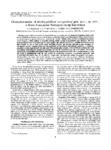Por favor, use este identificador para citar o enlazar este ítem:
http://www.alice.cnptia.embrapa.br/alice/handle/doc/608404Registro completo de metadatos
| Campo DC | Valor | Lengua/Idioma |
|---|---|---|
| dc.contributor.author | BALDANI, J. I. | pt_BR |
| dc.contributor.author | BALDANI, V. L. D. | pt_BR |
| dc.contributor.author | SELDIN, L. | pt_BR |
| dc.contributor.author | DOBEREINER, J. | pt_BR |
| dc.date.accessioned | 2017-06-19T23:50:10Z | - |
| dc.date.available | 2017-06-19T23:50:10Z | - |
| dc.date.created | 1995-06-27 | pt_BR |
| dc.date.issued | 1986 | pt_BR |
| dc.identifier.citation | International Journal of Systematic Bacteriology, Washington, v. 36, p. 86-93, 1986. | pt_BR |
| dc.identifier.uri | http://www.alice.cnptia.embrapa.br/alice/handle/doc/608404 | pt_BR |
| dc.description | During a survey of the occurrence of Azospirillum spp. in cereal roots, we obtained 119 isolates which could not be identified as members of one of the three previously described Azospirillum species. These strains formed a very homogeneous group of N2-fixing, microaerobic, motile, vibrioid, gram-negative rod-shaped organisms which formed a veillike pellicle in semisolid medium similar to that of Azospirillum spp. However, the new isolates differed from Azospirillum spp. by their smaller cell width (0.6 to 0.7 μm), variable flagellation (one to three flagella on one or both poles), moist brownish colonies, and broader pH and oxygen tolerance for nitrogenase activity. Organic acids were the preferred carbon sources, but glucose, galactose, L-arabinose, mannitol, sorbitol, and glycerol were also used. The guanine-plus-cytosine content of the deoxyribonucleic acid was slightly lower than the guanine-plus-cytosine contents of Azospirillum spp. (66 to 67 mol%). Deoxyribonucleic acid hybridization experiments with 17 strains of the group showed 50 to 100% complementarity, while the levels of hybridization with the type strains of Azospirillum brasilense, Azospirillum lipoferum, and Azospirillum amazonense were 23, 15, and 6%, respectively. For these new isolates we propose a new genus, Herbaspirillum (the name refers to the habitat of the organisms, the roots of cereals, which are herbaceous seed-bearing plants). The type species is named Herbaspirillum seropedicae after the place where it was first isolated. The type strain is strain Z67, which has been deposited in the American Type Culture Collection as strain ATCC 35892 | pt_BR |
| dc.language.iso | eng | eng |
| dc.rights | openAccess | eng |
| dc.subject | UAPNPBS | pt_BR |
| dc.subject | Diazotrofo | pt_BR |
| dc.title | Characterization of Herbaspirillum seropedicae gen. nov., sp. nov., a root-associated nitrogen-fixing bacterium. | pt_BR |
| dc.type | Artigo de periódico | pt_BR |
| dc.date.updated | 2017-06-19T23:50:10Z | pt_BR |
| dc.subject.thesagro | Gramínea | pt_BR |
| dc.subject.thesagro | Raiz | pt_BR |
| dc.subject.nalthesaurus | Herbaspirillum seropedicae | pt_BR |
| riaa.ainfo.id | 608404 | pt_BR |
| riaa.ainfo.lastupdate | 2017-06-19 | pt_BR |
| Aparece en las colecciones: | Artigo em periódico indexado (CNPAB)  | |
Ficheros en este ítem:
| Fichero | Descripción | Tamaño | Formato | |
|---|---|---|---|---|
| CharacterizationofHerbaspirillumseropedicaegen.nov.sp.nov.arootassociatednitrogenfixingbacterium.pdf | 2,68 MB | Adobe PDF |  Visualizar/Abrir |









